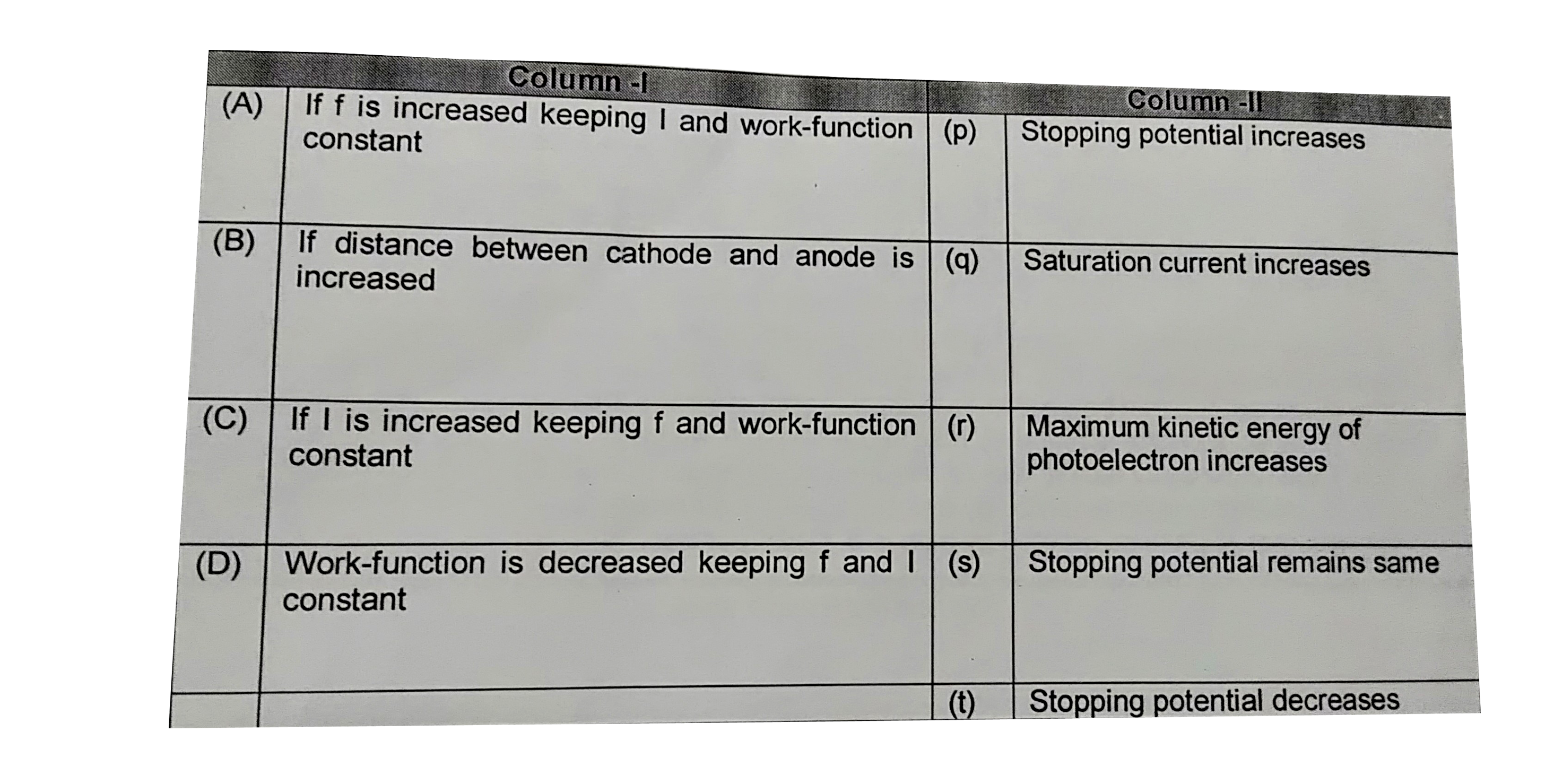In photoelectric effect light of certain frequency (> threshold frequency ) is incident on a metal surfave whereby , an e− ( with certain K.E.) moves towards the collector plate and a flow of current is initiated . In order to stop the current flow, an opposite potential , on the two metal plates, is applied
A light of frequency 2.5×1015Hz is incident on a metal surface having work function 4 eV. The velocity of photoelectron is ( in cm s−1)
1.5×106
1.5×108
2×108
2.5×104
The correct Answer is:2
To solve the problem regarding the photoelectric effect, we can follow these steps:
Step 1: Understand the given data
- Frequency of incident light, ν=2.5×1015Hz
- Work function of the metal, ϕ=4eV
Step 2: Convert the work function from eV to Joules
The work function in Joules can be calculated using the conversion factor 1eV=1.6×10−19J:
ϕ=4eV×1.6×10−19J/eV=6.4×10−19J
Step 3: Calculate the energy of the incident photons
The energy of the incident photons can be calculated using the formula:
E=hν
Where h=6.626×10−34J s (Planck's constant). Thus,
E=6.626×10−34J s×2.5×1015Hz=1.6565×10−18J
Step 4: Calculate the kinetic energy of the emitted photoelectron
The kinetic energy (K.E.) of the emitted photoelectron can be calculated using the equation:
K.E.=E−ϕ
Substituting the values:
K.E.=1.6565×10−18J−6.4×10−19J=1.0165×10−18J
Step 5: Relate kinetic energy to velocity
The kinetic energy of the emitted electron is also given by:
K.E.=12mv2
Where m is the mass of the electron, m=9.1×10−31kg. Rearranging for v:
v=√2×K.E.m
Substituting the values:
v=√2×1.0165×10−18J9.1×10−31kg
Step 6: Calculate the velocity
Calculating the above expression:
v=√2.033×10−189.1×10−31=√2.23×1012≈1.49×106m/s
Step 7: Convert the velocity to cm/s
To convert from meters per second to centimeters per second:
v=1.49×106m/s×100=1.49×108cm/s
Final Answer
The velocity of the photoelectron is approximately 1.49×108cm/s.
---
- Frequency of incident light, ν=2.5×1015Hz
- Work function of the metal, ϕ=4eV
The work function in Joules can be calculated using the conversion factor 1eV=1.6×10−19J:
ϕ=4eV×1.6×10−19J/eV=6.4×10−19J
The energy of the incident photons can be calculated using the formula:
E=hν
Where h=6.626×10−34J s (Planck's constant). Thus,
E=6.626×10−34J s×2.5×1015Hz=1.6565×10−18J
The kinetic energy (K.E.) of the emitted photoelectron can be calculated using the equation:
K.E.=E−ϕ
Substituting the values:
K.E.=1.6565×10−18J−6.4×10−19J=1.0165×10−18J
The kinetic energy of the emitted electron is also given by:
K.E.=12mv2
Where m is the mass of the electron, m=9.1×10−31kg. Rearranging for v:
v=√2×K.E.m
Substituting the values:
v=√2×1.0165×10−18J9.1×10−31kg
Calculating the above expression:
v=√2.033×10−189.1×10−31=√2.23×1012≈1.49×106m/s
To convert from meters per second to centimeters per second:
v=1.49×106m/s×100=1.49×108cm/s
The velocity of the photoelectron is approximately 1.49×108cm/s.
Topper's Solved these Questions
- STRUCTURE OF ATOM BOOK - AAKASH INSTITUTE ENGLISHCHAPTER - STRUCTURE OF ATOM EXERCISE - ASSIGNMENT ( SECTION -E) Assertion - Reason Type Questions
10 Videos
- STRUCTURE OF ATOM BOOK - AAKASH INSTITUTE ENGLISHCHAPTER - STRUCTURE OF ATOM EXERCISE - ASSIGNMENT ( SECTION -F) Matrix - Match Type Questions
4 Videos
- STRUCTURE OF ATOM BOOK - AAKASH INSTITUTE ENGLISHCHAPTER - STRUCTURE OF ATOM EXERCISE - ASSIGNMENT ( SECTION -C) Objective Type Questions (More than one options are correct)
15 Videos
- STRUCTURE OF ATOMBOOK - AAKASH INSTITUTE ENGLISHCHAPTER - STRUCTURE OF ATOMEXERCISE - ASSIGNMENT (SECTION -D) Assertion-Reason Type Questions
15 Videos
- SURFACE CHEMISTRY BOOK - AAKASH INSTITUTE ENGLISHCHAPTER - SURFACE CHEMISTRY EXERCISE - Assignment Section - C (Assertion - Reason type questions)
10 Videos
Similar Questions
In photoelectric effect light of certain frequency (> threshold frequency ) is incident on a metal surfave whereby , an e− ( with certain K.E.) moves towards the collector plate and a flow of current is initiated . In order to stop the current flow, an opposite potential , on the two metal plates, is applied
The work function of a metal is 4eV. If light of frequency 2.3×1015Hz is incident on metal surface, then
View SolutionIn photoelectric effect light of certain frequency (> threshold frequency ) is incident on a metal surfave whereby , an e− ( with certain K.E.) moves towards the collector plate and a flow of current is initiated . In order to stop the current flow, an opposite potential , on the two metal plates, is applied
The work function of metal is 6eV . If light of frequency 1×1015Hz is incident on the metal , intensity of light is increased 4 times, then
View SolutionIn photoelectric effect, what is meant by the term .threshold frequency.?
View SolutionIn photoelectric effect the slope of stop of stopping potential versus frequency of incident light for a given surface will be
View SolutionThe threshold frequency for a certain metal is 3.3×1014 Hz. If light of frequency 8.2×1014 Hz is incident on the metal, predict the cut-off voltage for the photoelectric emission.
View SolutionThe photoelectric threshold frequency of a metal is v. When light of frequency 4v is incident on the metal . The maximum kinetic energy of the emitted photoelectrons is
View SolutionThe photoelectric threshold of a certain metal is 3000A. If the radiation of 2000A is incident on the metal
View SolutionIn the photoelectric effect experiment, if f is the frequency of radiation incident on the metal surface and I is the intensity of the intensity radiations, then match the following columns:

View SolutionLight of frequency 1.5 times the threshold frequency is incident on a photodsensitive material . What will be the photoelectric current if frequency is halved and intensity is doubled
View SolutionThe threshold frequency of a certain metal is 3.3×1014Hz. If light of frequency 8.2×1014Hz is incident on the metal, predict the cut off voltage for photoelectric emission. Given Planck's constant, h=6.62×10−34Js.
View Solution
